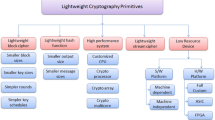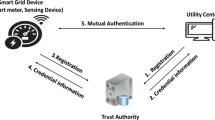Abstract
Mobile environment has been used in large area range of network. In order to secure communication, a number of schemes have been proposed. The typical schemes are two-party authentication key exchange (2PAKE) protocols. It is based on elliptic curve cryptosystem. The main weakness of the protocol is that attackers have the ability to impersonate a legal user at any time. In addition, it is vulnerable to the public key problem and unknown key share attack. In this paper, we propose a 2PAKE protocol. Our protocol is indeed safer and meets the needs. Hence, the proposed protocol has a great contribution to the area of mobile environment.


Similar content being viewed by others
References
Diffie, W., & Hellman, M. (1976). New directions in cryptography. IEEE Transactions on Information Theory IT, 22(6), 644–654. doi:10.1109/TIT.1976.1055638.
Bellovin, S. M., & Merrit, M. (1992). Encrypted key exchange: Password-based protocols secure against dictionary attacks. In Proceedings of IEEE symposium on research in security and privacy (pp. 72–84). Oakland: IEEE.
Bellare, M., & Rogaway, P. (1993). Entity authentication and key distribution. In Advances in Cryptology—Crypto’93 (pp. 232–249). Berlin: Springer.
Bellar, M., & Pointcheval, D. (2000). Authenticated key exchange secure against dictionary attacks. In Advances in Cryptology—Eurocrypt’00 (pp. 232–249). Berlin: Springer.
Vergados, D., & Stergiou, G. (2007). An authentication scheme for ad-hoc networks using threshold secret sharing. Wireless Personal Communications, 43(4), 1767–1780.
Tchepnda, C., Moustata, H., Labiod, H., & Bourdon, G. (2009). On analyzing the potential of a layer-2 muti-hop authentication and credential delivery scheme for vehicular communication. Wireless Personal Communications, 51(1), 31–52.
Phan, R., Wu, J., Ouafi, K., & Stinson, D. (2011). Privacy analysis of forward and backward untraceable RFID authentication schemes. Wireless Personal Communications, 61(1), 69–81.
He, D., Chen, J., & Hu, J. (2011). Further improvement of Juang et al.’s password-authenticated key agreement scheme using smart cards. Kuwait Journal of Science and Engineering, 38(2A), 55–68.
Miller, V. S. (1986). Use of elliptic curves in cryptography. Proceedings of Advances in Cryptology—CRYPTO, 85, 417–426.
Koblitz, N. (1987). Elliptic curve cryptosystem. Mathematics of Computation, 48, 203–209.
Yang, J. H., & Chang, C. C. (2009). An ID-based remote mutual authentication with key agreement scheme for mobile devices on elliptic curve cryptosystem. Computers and Security, 28, 138–143. doi:10.1016/j.cose.2008.11.008.
Hankerson, D., Menezes, A., & Vanstone, S. (2004). Guide to elliptic curve cryptography. New York: Springer.
Yoon, E., & Yoo, K. Y. (2009). Robust ID-based remote mutual authentication with key agreement protocol for mobile devices on ECC. In Proceedings of 2009 international conference on computional science and engineering (pp. 633–640). doi: 10.1109/CSE.2009.363.
He, D., Chen, J., & Hu, J. (2011). An ID-based client authentication with key agreement protocol for client-server environment on ECC with provable security. Information Fusion, 13, 223–230. doi:10.1016/j.inffus.2011.01.001.
Chou, C. H., Tsai, K. Y., & Lu, C. F. (2013). Two ID-based authenticated schemes with key agreement for mobile environments. The Journal of Supercomputing, 66, 973–988. doi:10.1007/s11227-013-0962-3.
Kaliski, B, Jr. (2001). An unknown key-share attack on the MQV key agreement protocol. ACM Transactions on Information and System Security, 4, 275–288. doi:10.1145/501978.501981.
He, D., Chen, Y., & Chen, J. (2013). An Id-based three-party authenticated key exchange protocol using elliptic curve cryptography for mobile-commerce environments. Arabian Journal for Science and Engineering, 38, 2055–2061. doi:10.1007/s13369-013-0575-4.
Yoon, E., Choi, S., & Yoo, K. (2012). A secure and efficiency ID-based authenticated key agreement scheme based on elliptic curve cryptosystem for mobile devices. International Journal of Innovative Computing, Information and Control, 8(4), 2637–2653.
Author information
Authors and Affiliations
Corresponding author
Rights and permissions
About this article
Cite this article
Yang, H., Chen, J. & Zhang, Y. An Improved Two-Party Authentication Key Exchange Protocol for Mobile Environment. Wireless Pers Commun 85, 1399–1409 (2015). https://doi.org/10.1007/s11277-015-2847-7
Published:
Issue Date:
DOI: https://doi.org/10.1007/s11277-015-2847-7




